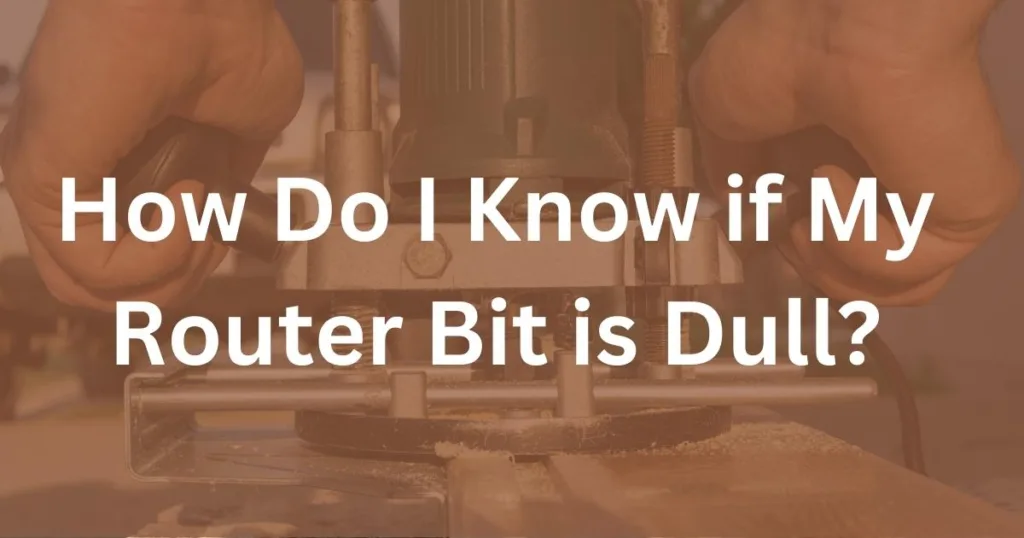
Have you ever wondered when it was time to change your router bit? Surely it has to wear out at some point, right? I did a little research on this exact question and this is what I found out.
The best way to determine if a router bit is dull is with a visual inspection of the cutting edge, preferably using a magnifying glass if available. If the bit is dull, there will be a shiny reflection along the cutting edge. This is due to the cutting edge of the metal being slightly rolled over. When a bit is sharp, you will not see a reflection on the cutting edge.
Alternate Methods for Checking if a Router Bit is Dull
The visual inspection method is probably the best inspection for checking if a router bit is dull, but it is not the only way. There are a few different signs of a wearing router bit.
Excessive Feed Resistance
If you are experiencing a lot of resistance when feeding the router, it could be an early sign of a wearing bit. However, this may not be the only reason for a lot of resistance. Trying to feed the router too fast or trying to remove too much material in a single pass can also cause excessive resistance. Check the bit with a visual inspection if you have a lot of resistance to see if it is to blame.
Rough Finish or Tear Out
When you have made a pass with the router and notice a rough finish, this too could be a sign of a dull bit. A router bit has a thin sharp edge that is designed to slice through the wood. When your bit begins to dull, this thin edge starts to roll over, which causes it to be thicker. After this happens, the router bit tends to hit the wood with a blunt edge which rips the wood instead of slicing it cleanly.
Should You Sharpen Your Router Bit?
If your router bit has started to dull, you may want to look at sharpening the bit to give it back its original edge. If the router bit is only slightly dull, there are some easy methods you can use to help give the router bit its edge back. It is recommended to only give the bit a few passes with a fine honing stone. Any more than this, and you can begin to change the diameter of the blade or cause it to become unbalanced. After a few times of using the honing stone, you may want to look at having it professionally sharpened or just replacing the bit altogether.
If the bit is part of a set or used to make precise cuts you may want to go ahead and look at just replacing the bit or the set. When you sharpen a router bit, you are removing material which can have negative effects depending on the router bits’ purpose. Sharpening the router bits may be the best option if the bit is expensive or if the accuracy is not as critical. Purchasing another router bit altogether may be the better option if the bit is part of a set or if the router bit is cheap to replace. In the end, it comes down to your specific use case and what better fits your scenario.
Should You Clean Router Bits?
Yes, you should clean your router bits routinely. This will help keep your router bits edge sharp. If your router bit is dirty and has a build-up of junk, it can hinder its ability to cut cleanly. As junk builds up on the router bit, it will cause the blade to have the same effect as if it were dull. It will cause tear-out and burning of the wood.

Using a solvent and a brass wire brush, you should clean the router bit itself. First be sure to remove any bearings that may be attached to the bit, as the solvent will break down the lubricant in the bearing. You can use the solvent to clean the surface of the bearing, just be careful to not get it inside. Before reattaching the bearing, you can also lubricate the bearing with high-speed, bearing lubricant. Woodmagazine.com has a good summary of how to clean your bearing-guided router bits which you can find here.
Carbide-Tipped vs. High-Speed Steel Router Bits
When choosing a router bit, one is faced with a decision: carbide-tipped or high-speed steel (HSS)? A carbide-tipped router bit is made of steel but has been altered so that the cutting edge is made of carbide. Carbide, which is the shortened term for tungsten carbide, is a very strong material. When a blade or cutting edge is tipped with carbide, it can last anywhere from 10 to 20 times longer than its typical HSS counterpart. So why not just purchase a carbide-tipped router bit, to begin with? Well, this is where the difference comes into play.
A carbide-tipped bit is much more expensive than HSS. If you are just getting started in woodworking, it can be hard to purchase all the necessary bits with the increased cost difference. If you won’t be using the router bit very often, it may not be worth spending the extra cash for the carbide-tipped version. Which bit you choose will all be dependent on your budget and your specific use. If you have the money and will be using the bit quite often, the carbide-tipped router bit is the way to go.
Which Router Bit is Best for a Beginner?
If you are just getting started, it can be hard to justify buying a $150 router bit set. With just a handful of bits, you can get started and don’t have to break the bank.
Round Over Bit
A round-over bit has a curved cutting surface, with a bearing on the bottom. These bits are great for applying a radius to the outside edge of a board. They come in different sizes, which will change the radius that they have.

Chamfer Bit
A chamfer bit is used to create a beveled edge on the work surface. They come in different degree increments. If you are just going to purchase one bit, we recommend going for the 45-degree bit for starters.
Flush Trim Bit
A flush trim bit is possibly one of the most used bits in a workshop. It can trim shelf edging and laminate. It can also be used in conjunction with a template to cut out duplicate parts. It is a very versatile tool and is a must-have for the beginner woodworker.
Straight Cut Bit
A straight-cut bit is like a flush-trim bit without the bearing. It is great for making cuts that won’t be on the edge of the board. It is also a useful tool for cutting out different joints such as rabbets, tenons, and inlays. It can be a very versatile bit and is a recommended beginners purchase.


